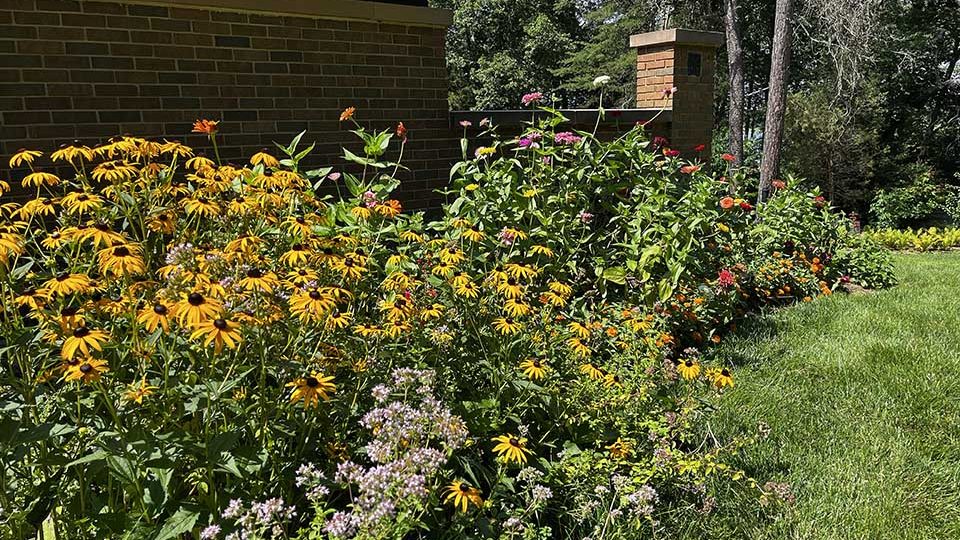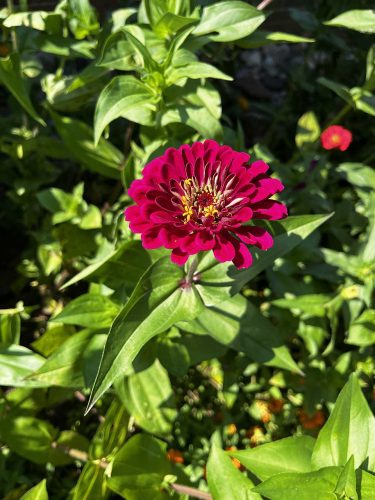Artful Arranging
What does Martha Stewart say about bringing your hydrangea and zinnias indoors?


Last week our article was about one of our native hydrangea shrubs, oakleaf hydrangea. Researching the plant took me on an internet surf that changed into a riptide, where I was dragged parallel to shore thinking I might never put my feet on dry land again!
During this journey I stumbled on an article about how to cut hydrangea blooms for display in the home. The article was written by none other than Martha Stewart. I have been cutting blossoms from the summer and fall garden for years, but I discovered that I actually know absolutely nothing about it—I mean nothing. So think of this as my girlfriend column, as in “GIRL, I’m just saying….”
Years ago I went to a Japanese garden where someone was making an arrangement using about four blooms, which by the way was stunning in the end. I watched that person recut the stems underwater and handle the flowers as if they were priceless pages from the Book of Kells. The process of positioning each flower took countless minutes. Clearly it was about the journey and not only the destination. I realized then that the art of cutting and displaying flowers was likely not my forte. But it hasn’t kept me from tossing stemmed fancies together for the dining table.
Because of this journey I have decided to make you, the reader, weather some of the storms of information that I uncovered about cutting flowers from your garden for display in your home. After reading countless articles I still don’t feel up to the task of detailing the endless nuggets of advice that I have endured, but I will attempt to share a few. Nor do I think my little displays are up to the standards of the enlightened, but I enjoy them and naturally have some opinions to share.
So let’s open with Martha Stewart and her hydrangeas, shall we? One of my best friends has Martha on a pedestal; I do not share this perspective but I’m sure it is simply domestic envy, because my friend is generally right, about everything.
So Martha (we are on a first name basis, you know) assures us that if hydrangea is cut “incorrectly” it will wilt quickly. Right out of the box I realize I haven’t a prayer. “Oh Martha, go on.”
“Whether you display the cut blooms on their own in a vase or use them as a textural component in flower arrangements, the beloved florals will add a pop of color to any room,” Martha continues.
She had me at “textural component” and “beloved.” I get it and even like it, but honestly if I said to my husband, “I added this flower or that one as a textural component to our beloved display,” he’d know I’d been smelling some garden herb or something. Possibly he’d begin asking me questions to check for signs of stroke.
So here are the basics of Martha’s shared advice.
Timing: The flower must be open and the color fully developed.
Cutting: Cut above a node (where a leaf meets the stem), and you must use sharp clean shears. You must include at least two leaf groups. Once inside the house with your treasure you must recut the stem on a diagonal (yes, the shears must still be clean) and then split the stem up the middle about one or two inches for maximum hydration.
Watering: Be sure to place it in water immediately, and change the water often to avoid bacteria build-up. You might also dip the stem in alum powder for great water absorption.
In keeping with my theme of surfing the internet (a nice way of saying that I can’t stay focused on the meat of a topic without investigating all unnecessary details), I began to wonder why the word “absorb” drops the “b” and changes to “p” when it morphs into a noun. According to Quora, “The change from b -> p was certainly a case of assimilation caused by the following voiceless consonant -t-. So, in those forms where the vowel -e- of absorbeo was elided the combination -bt- then became -pt-. The scholars who later introduced these terms into English knew their Latin and simply copied that.”
Is this a trusted answer? NO. But it is about as good as any of the other answers I found. I’m a horrific speller and words like this in no way help my issue.
 Okay, so those are the basics of Martha’s advice. But wait… what exactly is alum? You may know, but honestly I did not. Alum is short for aluminum potassium sulfate, a mineral refined from bauxite, which is a free-flowing crystal resembling salt. Ancient Egyptians mined it from the western desert and have used it for water treatment since 1500 BC. So it’s been known for over 3,000 years and no one told me!
Okay, so those are the basics of Martha’s advice. But wait… what exactly is alum? You may know, but honestly I did not. Alum is short for aluminum potassium sulfate, a mineral refined from bauxite, which is a free-flowing crystal resembling salt. Ancient Egyptians mined it from the western desert and have used it for water treatment since 1500 BC. So it’s been known for over 3,000 years and no one told me!
Aluminum potassium sulfate is used as a mordanting agent, such that when combined with a dye it affixes the color to cloth. Should you choose to use it, luckily for you spice manufacturers sell it as “alum,” a food additive that is ideal for pickling and canning. It makes fruits and vegetables crisp. And it just so happens that it enhances cut flowers’ ability to absorb water—absorb with a “b,” not a “p.”
So then I started to wonder, are those nifty little packets that you get with floral arrangements alum? No, no they are not. Most sources describe them as containing acid, sugar, and bleach. Sugar provides nutrients, acid maintains pH, and bleach reduces bacteria and fungi. Some packets also contain stem unpluggers, chemicals that prevent stems from closing. In my humble opinion most flowers are going to last about the same amount of time with or without it, so my advice: “fuhgeddaboudit.”
I like to grow some annuals each year to attract pollinators and for a big splash of color in the garden. I have found that zinnias are easy to cut and last as much as a week in the house, even with my rudimentary skills. But you guessed it, I couldn’t leave well enough alone so I had to seek out advice on YouTube and in articles.
At this point my surfboard is showing signs of wear and my eyes need a new prescription. And guess what I found out after 40 some years of gardening: I likely don’t know much about cutting zinnias either.
In this instance some of the takeaways were things I knew. When you cut flowers, cut them early in the day before the heat. Select a fresh bloom with petals that are fully spread. Feel under the bloom for firmness in the stem; it should be able to sway a bit when wiggled, and not bend. Cut zinnias at the node where two leaves meet; this way the plant will branch out and make more flowers. Before putting the bloom into your vase, strip the stem of lower leaves so the water supports the flower and the water doesn’t get as bacteria-laden. When inside arranging your blooms, recut the stem at an angle before placing it in the water. By the way, some sources mentioned alum for zinnias too, and my swaying-detection skills need a bit of work.
This is my advice: I like my flowers out-of-doors where they seem to do much better and are enjoyed by pollinators. My hummingbirds are crazy about my Ladies in Red Texas salvia. But for indoor arrangements I use a five-and-a-half-inch tall vase because it only takes about seven blooms to fill it. Also it doesn’t test my arranging abilities. I add rosemary and mint, which keeps green a long time and smells nice. Plus, if your ice tea or mojito is a bit shy on garnishes you don’t need to get up from the table; you can just steal a pinch. When the flowers are in place you should be able to see over them so your eyes are visible to your partner as you share your opinions or bat your lashes. My final advice: Go enjoy your garden and surf less! n
Sources:
- “How to Cut Hydrangeas in Your Garden So They Last Longer in Floral Arrangements,” MarthaStewart.com
- “What’s In Flower Food Packets That Come With Bouquets of Flowers?” Suzanne Raga, mentalfloss.com
- “3 Ways to Cut Zinnias to Keep Them Blooming,” Jessica Gaige, homegrownfoodandflowers.com









